1lumen selects and reviews products personally. We may earn affiliate commissions through our links, which help support our testing.
Wuben E6 review
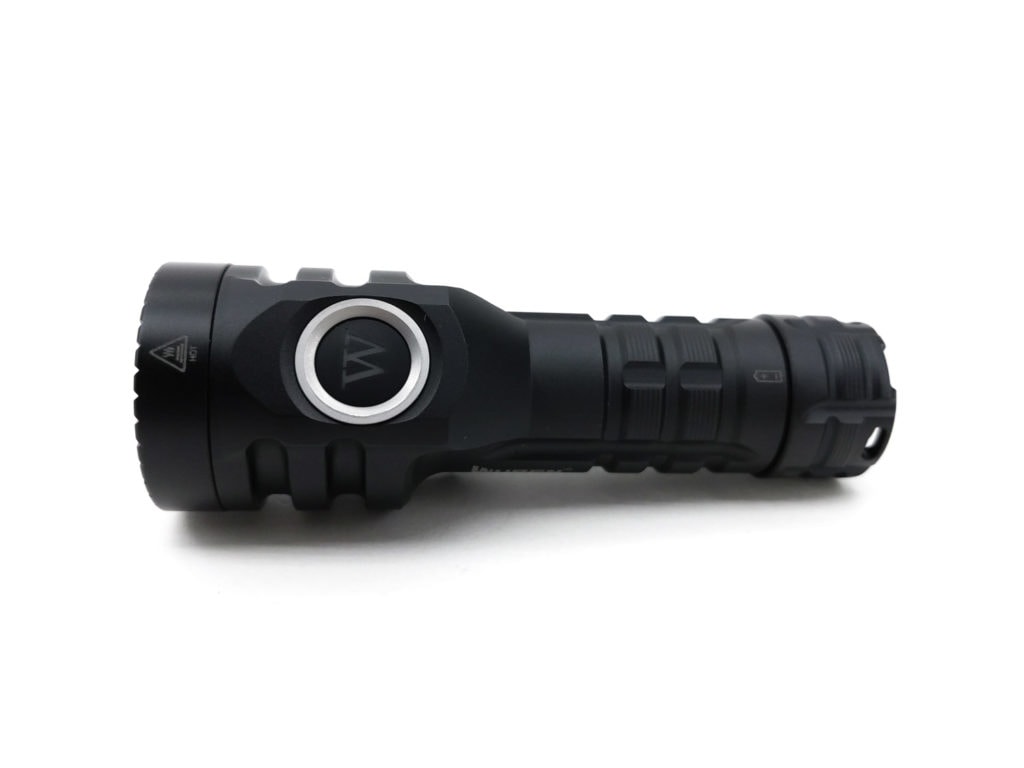
Wuben E6 specifications
| Brand/model | Wuben E6 “Small Steel Cannon” |
|---|---|
| LED | OSRAM KW CSLPM1.TG |
| Lumens | 900 lm |
| Beam intensity | 42,000 cd |
| Battery config. | 1*14500 / AA |
| Material | Aluminum |
| Modes | 3 |
| Blinkies | Strobe, SOS |
| Reflector | Smooth |
| Waterproof | IP68 |
| Review date | July 2021 |
Introduction:
Wuben was established in 1981 and has been producing flashlights for decades. Most of that time was spent as an OEM, but in 2016 they launched their own line of flashlights. I’ve owned several Wuben flashlights over the past few years and have been really impressed with their overall quality. What I’ve come to expect in Wuben flashlights: wonderful presentation, amazing build quality, great regulated buck/boost drivers, and lumens that actually meet or exceed the stock specifications.
The Wuben E6 has been dubbed by Wuben as the “Small Steel Cannon”. While the E6 isn’t actually made of steel, the manufacturer specs and overall design peg the E6 as being very strong and packing a punch, not unlike a cannon. If you hold it just right, the E6 even looks a bit like a cannon.
Package quality.
The Wuben E6 arrived in a very small and fairly simple-looking box, reminiscent of some other recent Wuben lights. White with decorations of blue, the E6 packaging has an image of the flashlight on the front along with a few key specs. The reverse side has a description of the light and a rundown of the specs. Opening the box, I found:
- Wuben E6
- Battery – 920mAh 14500 (in the light with protection disc)
- Spare o-rings
- Lanyard
- Manual

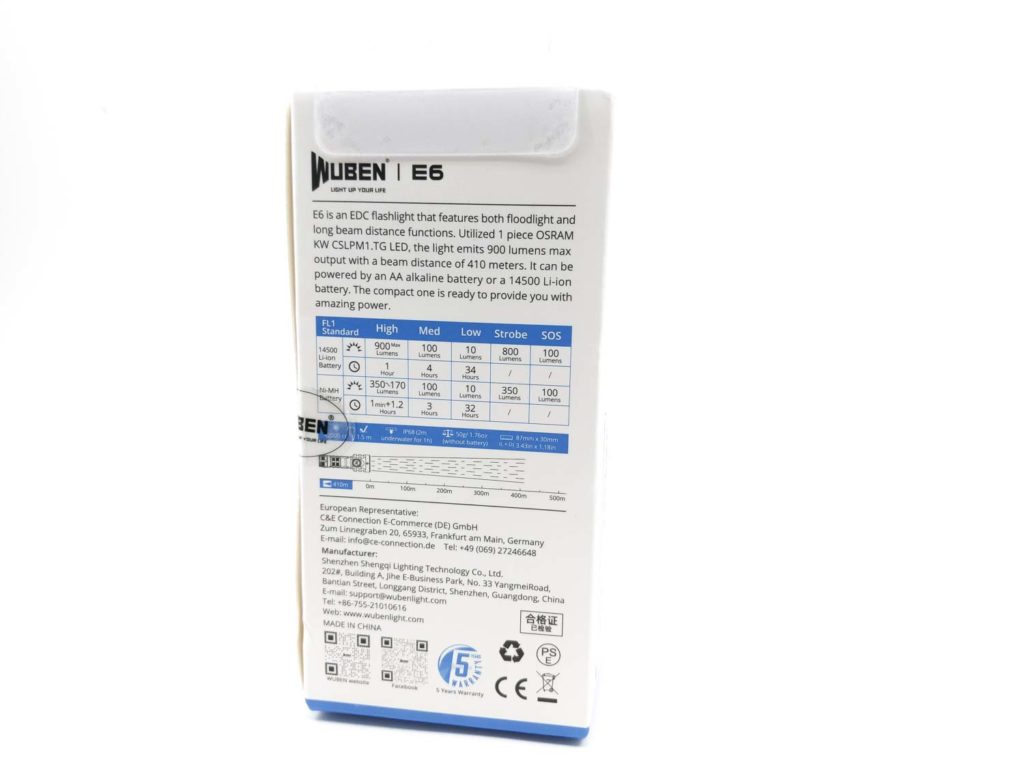
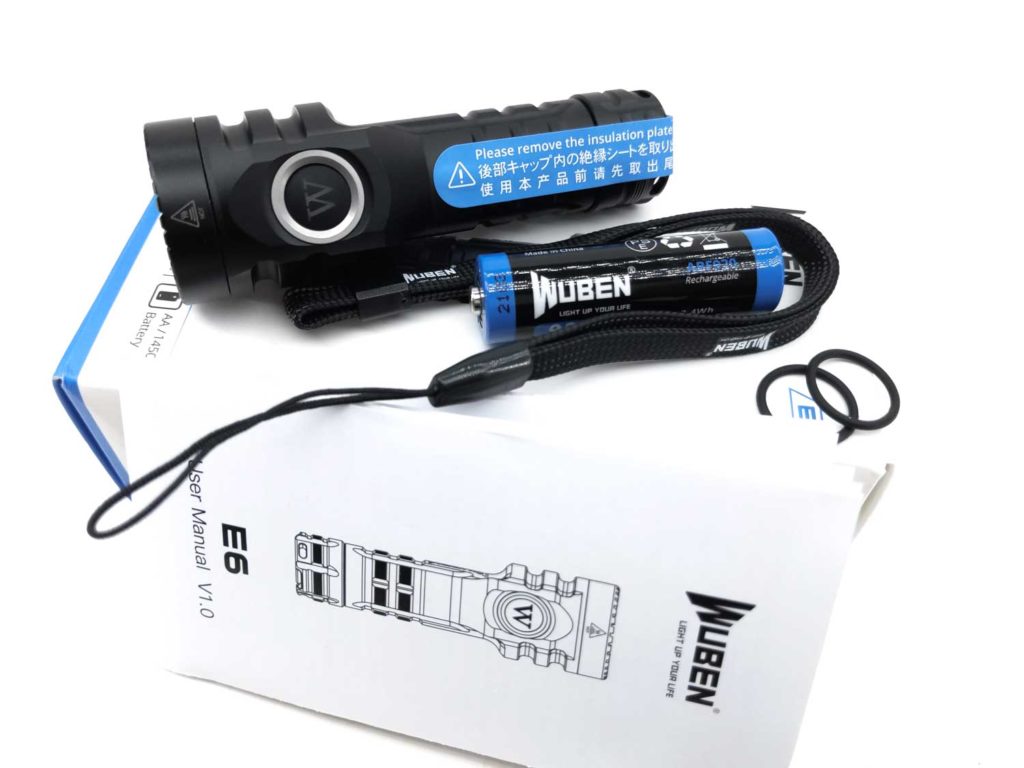
Flashlight in use
The Small Steel Cannon looks (and feels) strong. It kinda reminds me of a hand grenade. With all of the machining, the E6 is pretty grippy. There is a large and strong pocket clip installed from the factory that is held in place by two small hex-head screws. The clip is not deep carry, but for a unique light such as the E6, I can look past that. The included Wuben-branded lanyard is pretty standard, but appreciated. The tailcap is very flat, resulting in a stable tail-stand.
There is a single switch on the Wuben E6; an e-switch situated on the side of the head. It features the Wuben “W” and has red/blue LEDs under the switch that handle battery indication duties.
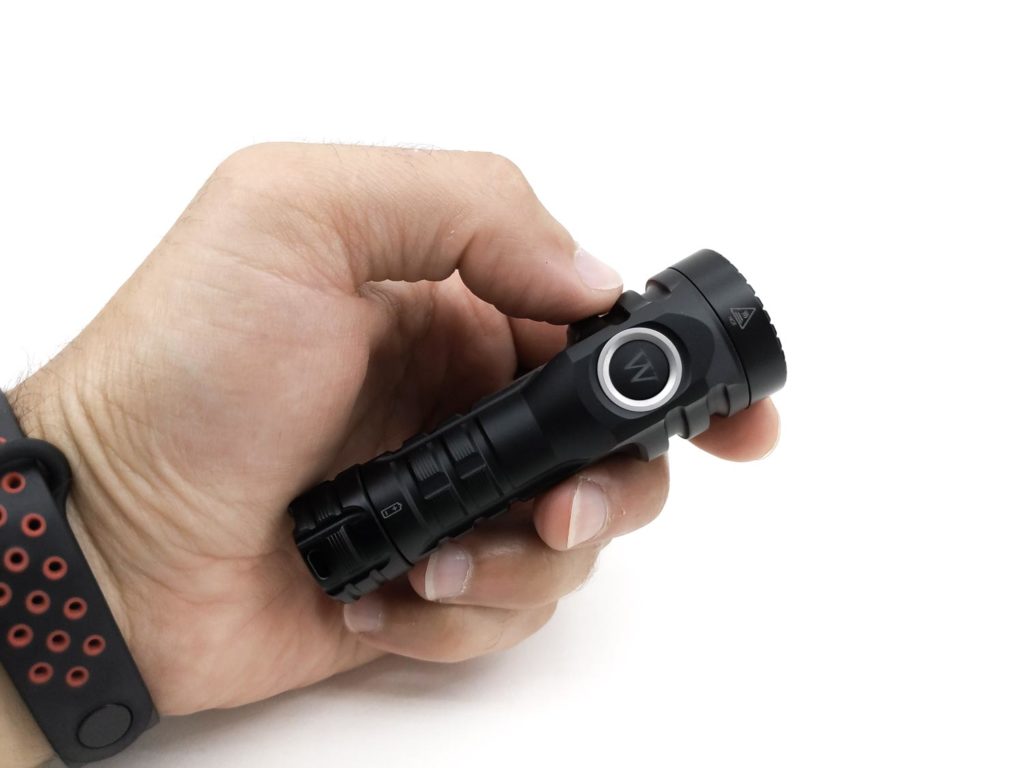
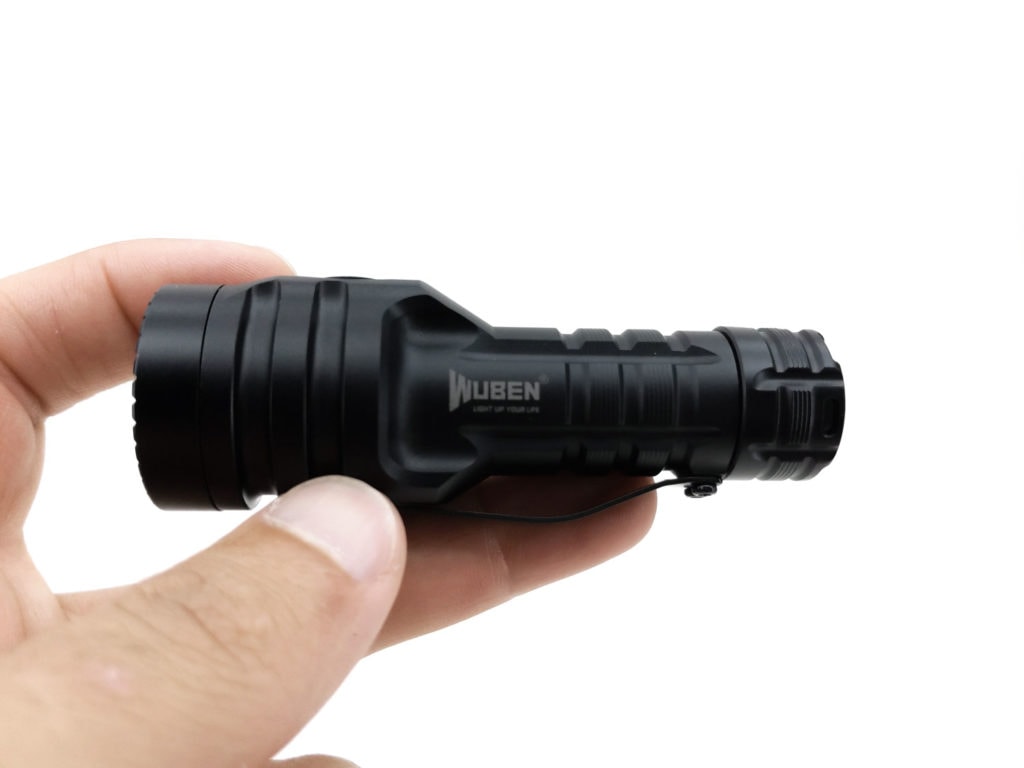
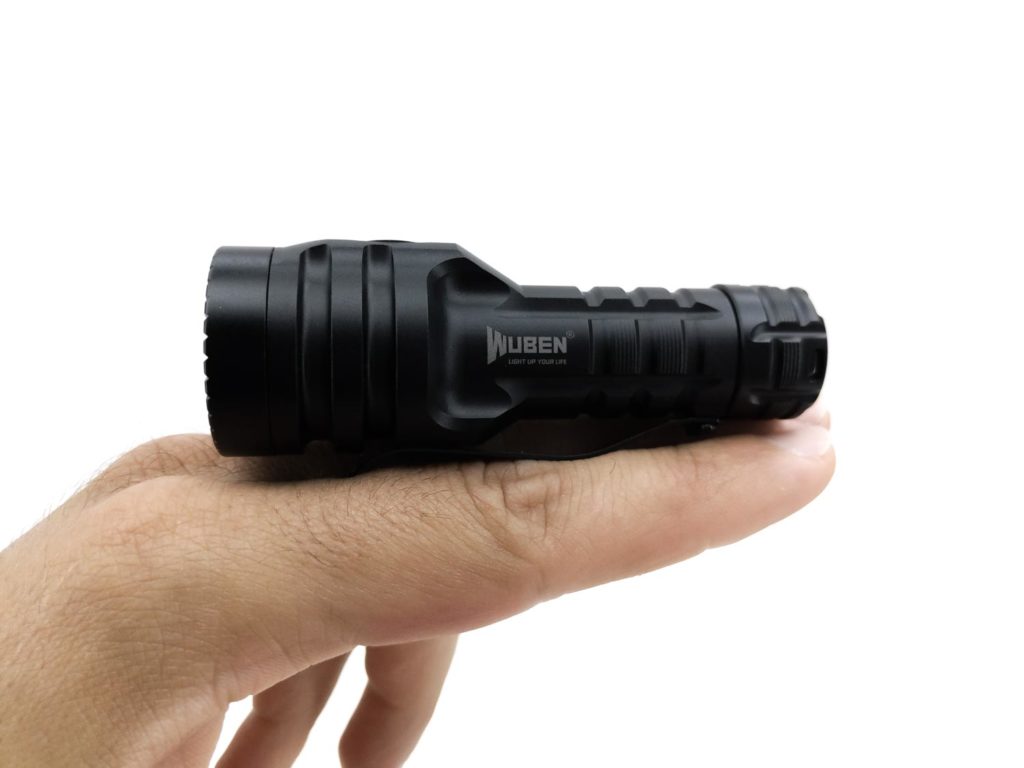
Build Quality, and Warranty
Wuben machined the E6 with grooves running both lengthwise as well as around the girth of the light. The grooves are featured on the body tube and continue onto the tailcap. The “Cannon” has a satin sheen and features a durable Hard-Anodized III finish. Threads are square-cut, cut, smooth, and pre-lubed.
The engraved Wuben logo, serial number, and requisite certification logos are very clear and detailed. Even the “Hot” icon is nicely aligned with the button, appeasing my OCD tendencies.
When it comes to warranty, Wuben offers:
- 5 year warranty coverage for the flashlight
- 1 year coverage for batteries
- Lifetime maintenance (paid repair) for registered customers
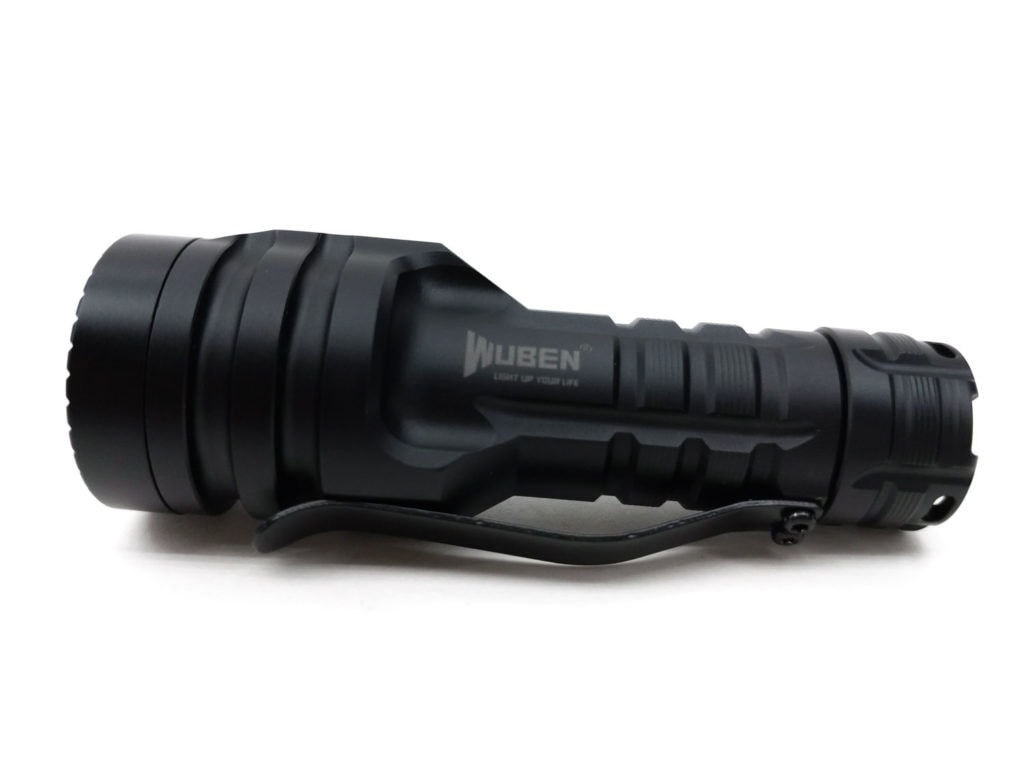
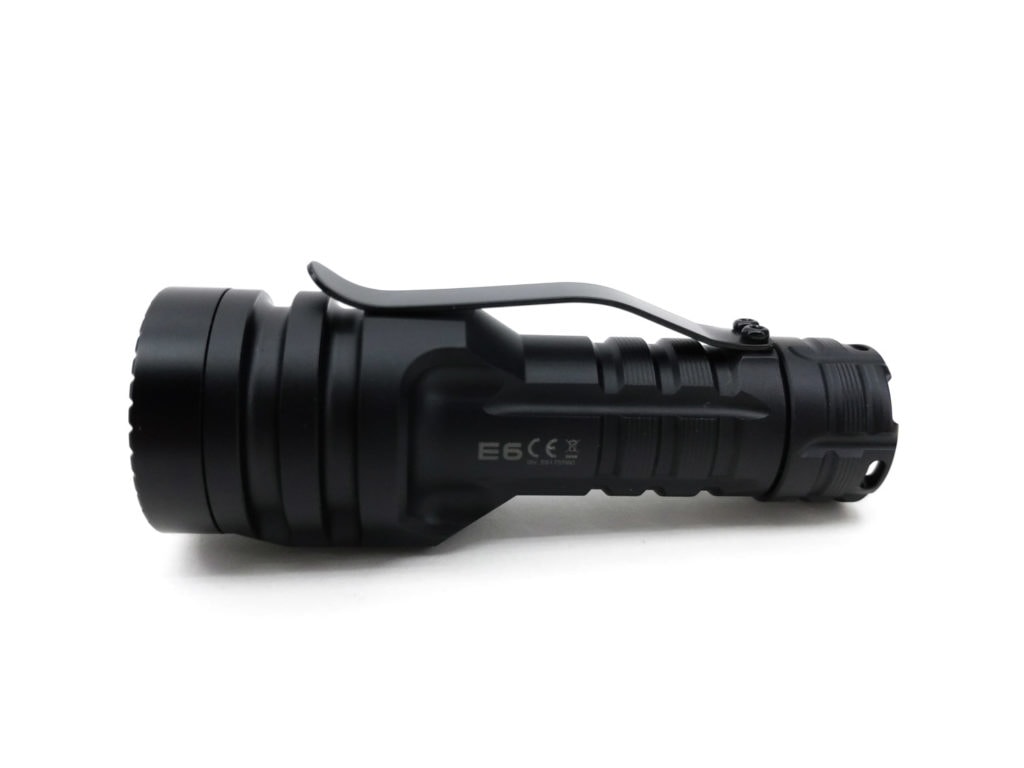
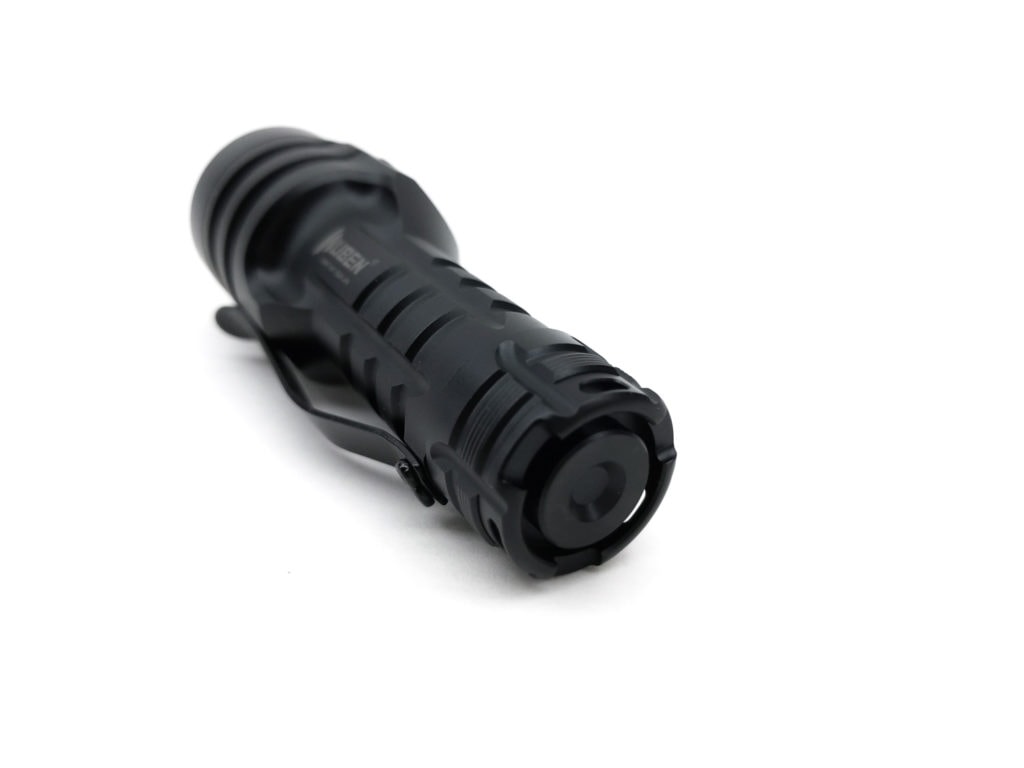
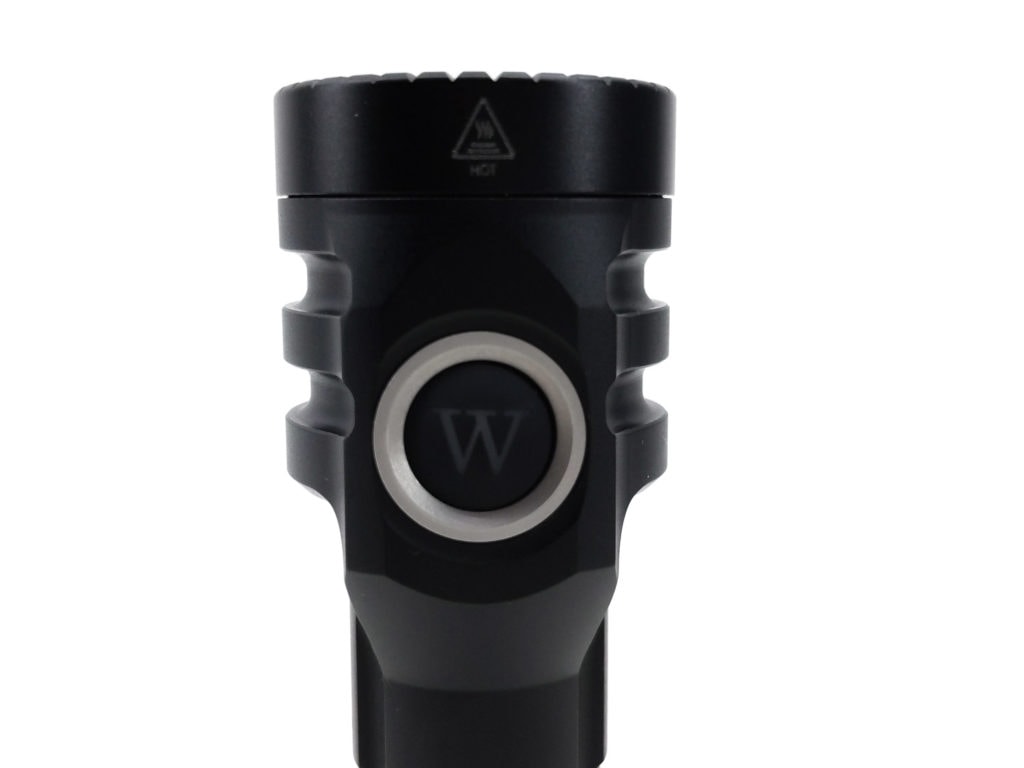
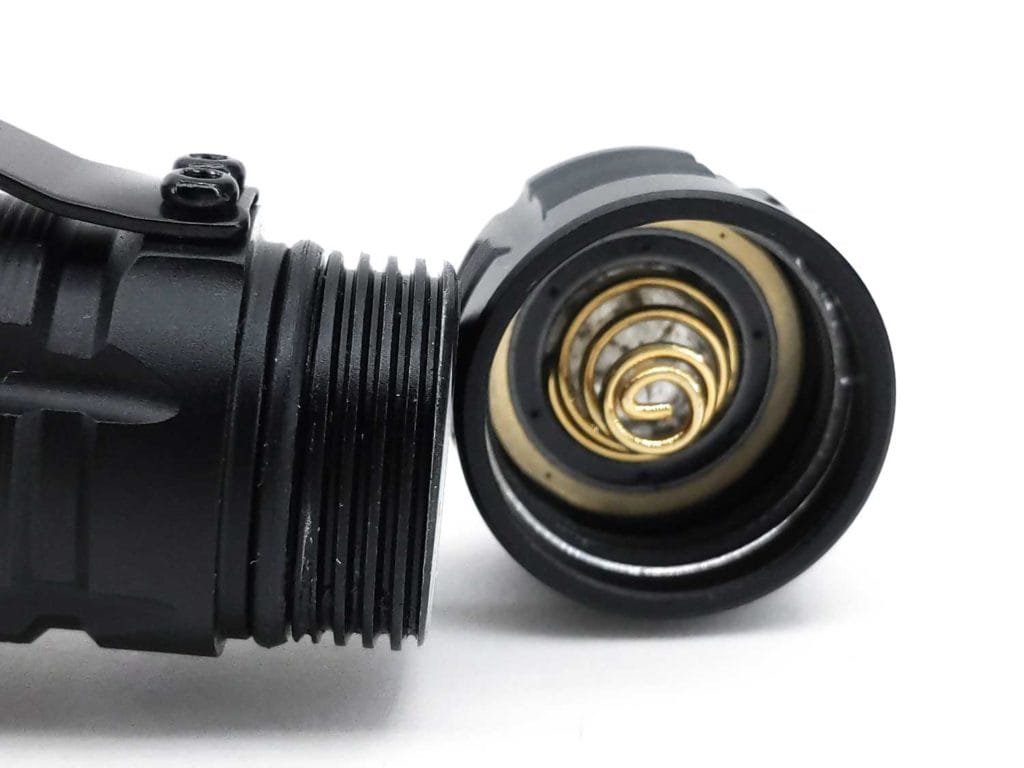
LED, Lens, Bezel, and Reflector
The Wuben E6 is all about throwing lumens down range from a small package. In order to make that happen, Wuben chose a domeless, throwy LED: the Osram KW CSLPM1.TG. That’s what some people may refer to as the “2mm2 White Flat”. The emitting surface is rectangular, but that doesn’t come out in the beam. What the beam does show, however, is a nice tight hotspot. Especially considering the small size of the Small Steel Cannon. Wuben does not specify a CCT for the E6, but this particular LED is pretty much exclusively available around 6000K: a bit cool, but not cold.
This light uses a smooth reflector to focus the beam. This creates a fairly small hotspot and a bit of spill. Everything is securely held in place by a bezel that seems to be glued. The bezel is mostly flat but has many small cuts that look like minute marks on a clock.
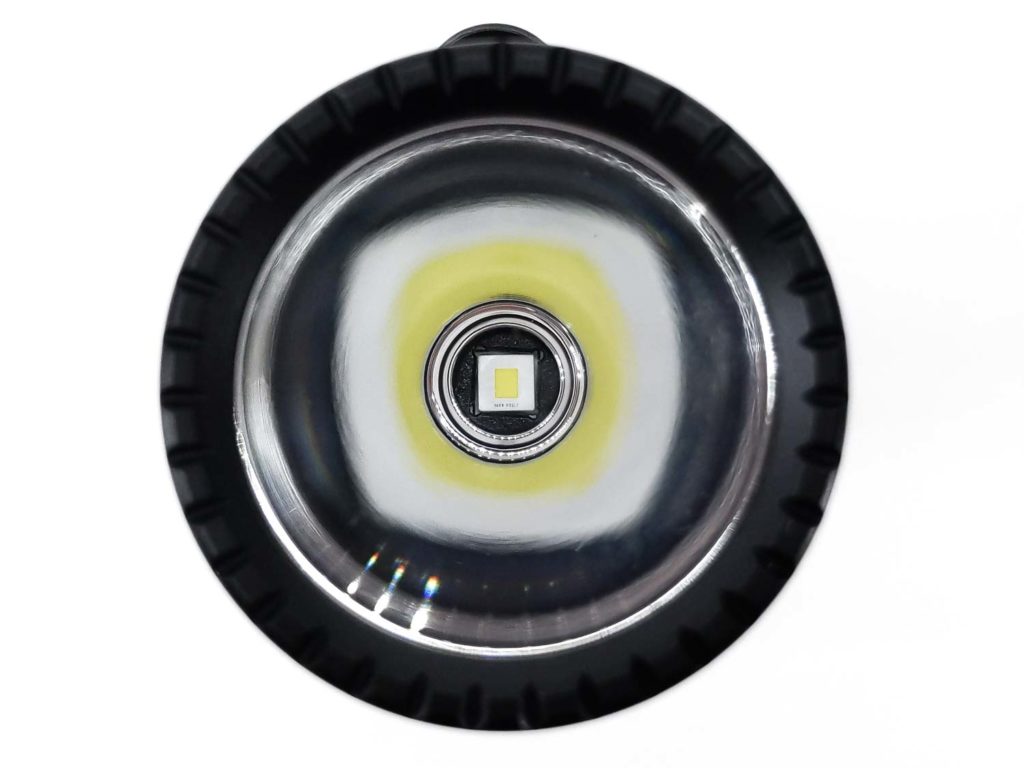
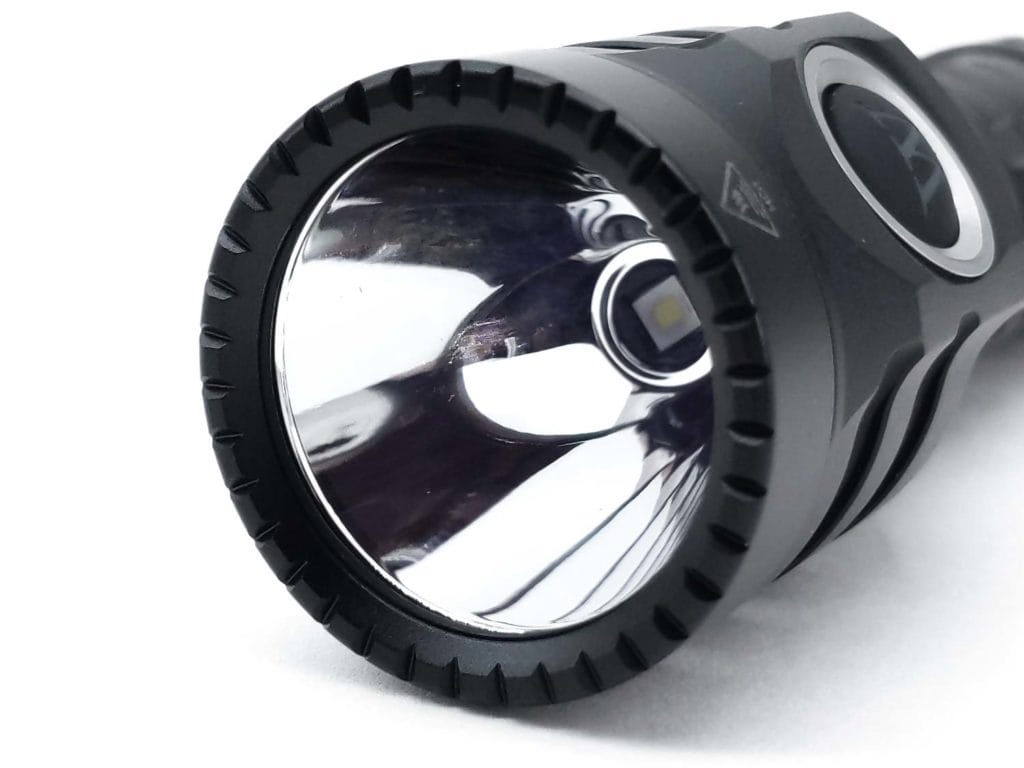
Dimensions and size comparison
- Length: 87 mm / 3.43 inches
- Head diameter: 30 mm / 1.18 inches
- Body diameter: 20 mm / 0.79 inches
Weight:
- With cells: 75 grams / 1.76 oz
- Without cells: 50 grams / 2.54 oz
Flashlight comparison
AA/14500 lights from left to right: Utorch UT01, Skilhunt E2A, Wuben E6, Sofirn SP10S, Reylight LAN TI
Compact throwers from left to right: Wuben E6, Manker MC13
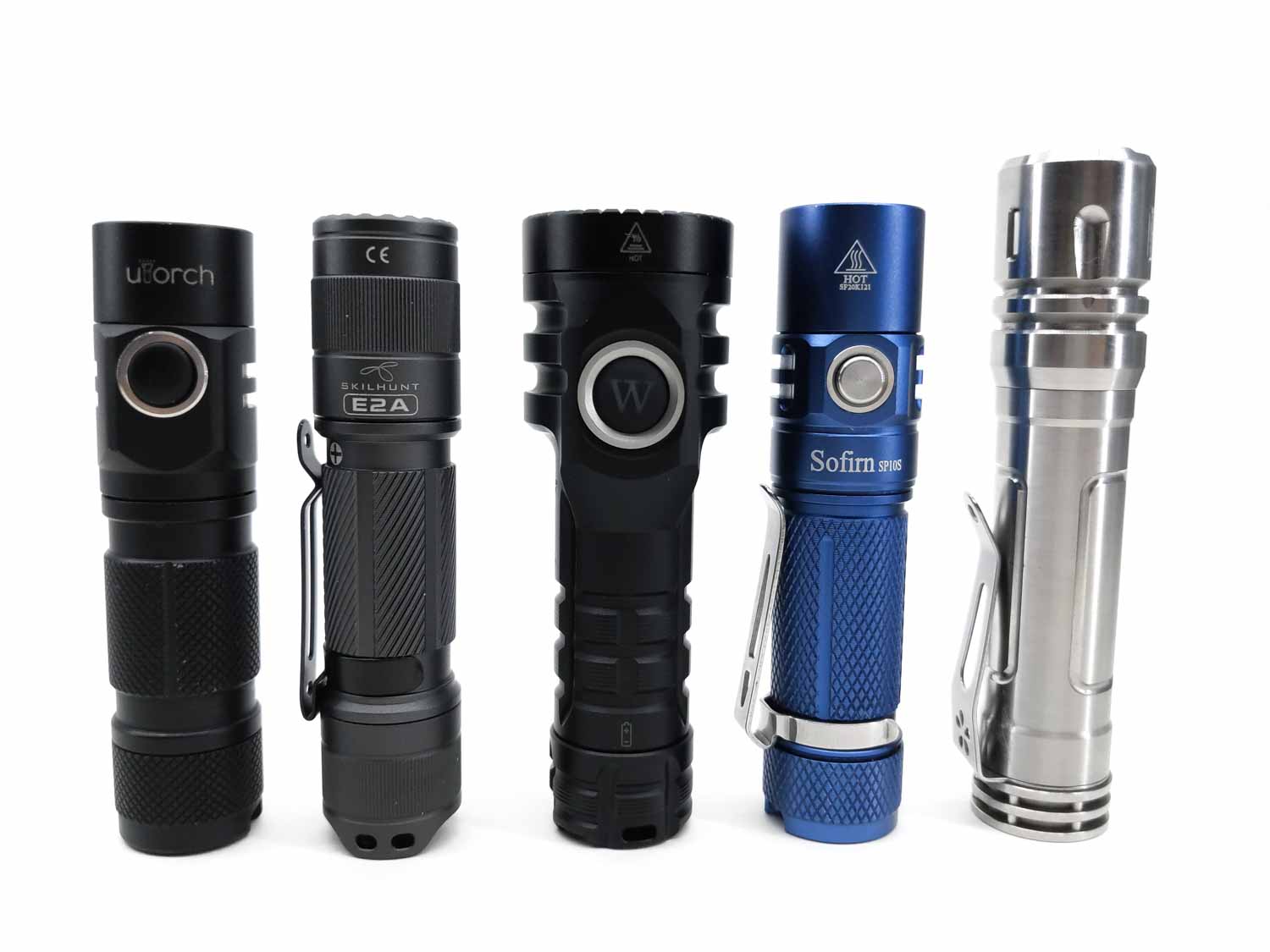
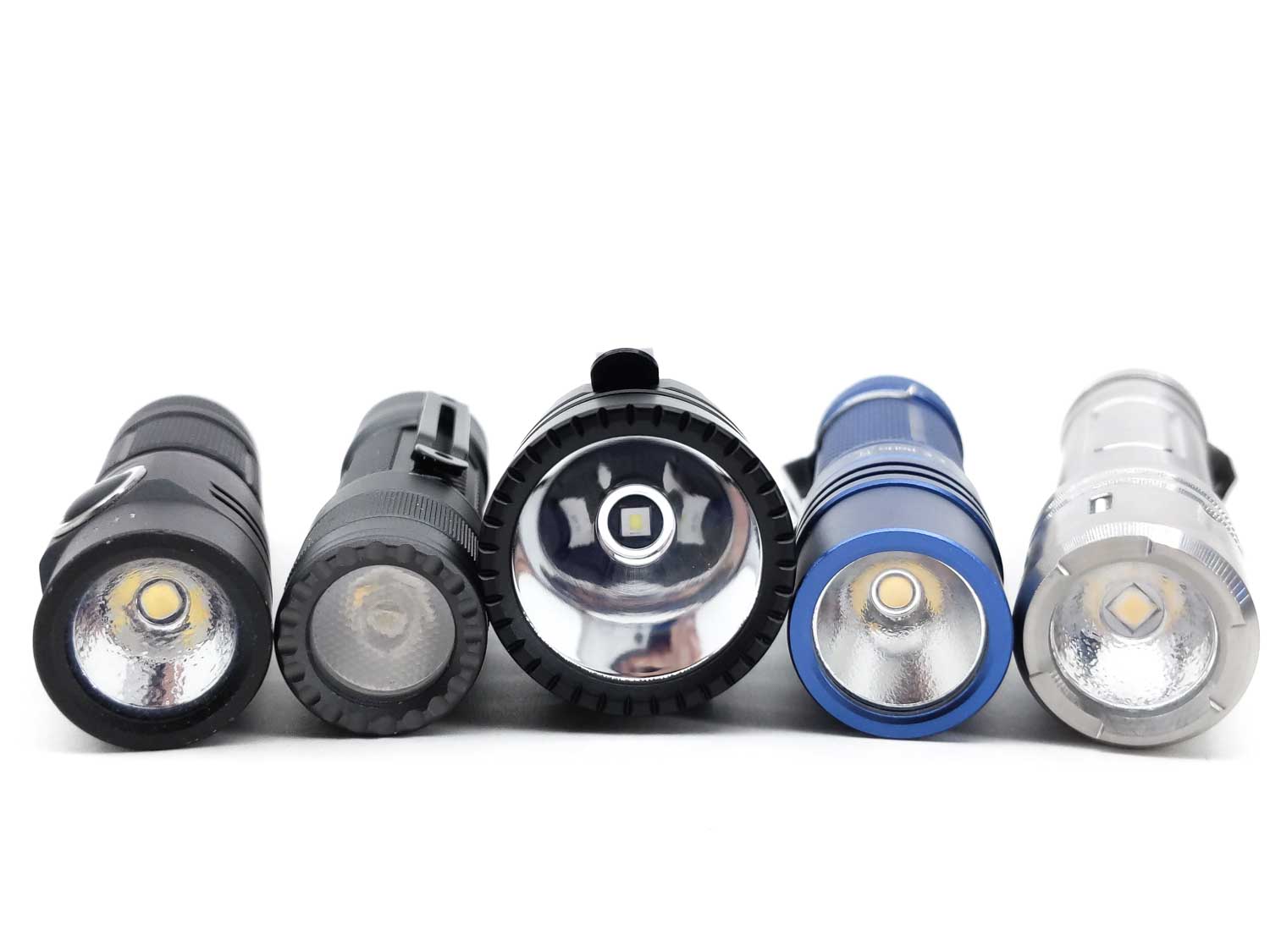

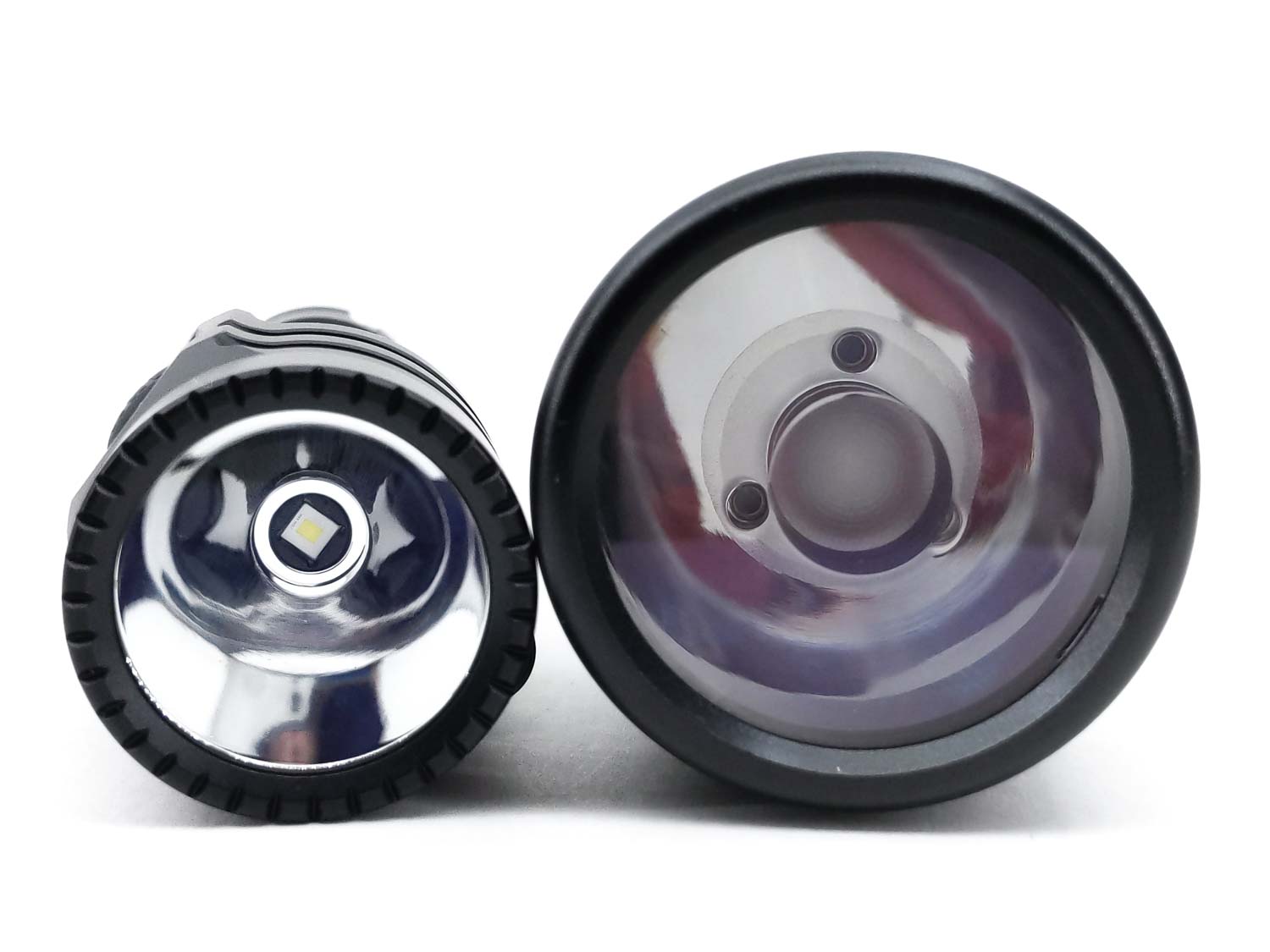
Driver & User Interface:
Being an AA-capable light, the Wuben E6 has a boost driver. The firmware that it’s running is fairly basic and easy to use.
Modes: Low, Medium, High, Strobe, SOS
From OFF:
- Single click: turn on in last used mode
- Double click: Strobe
- Triple click: enable/disable “breathing light”
- 4x click: lockout
From ON:
- Single click: turn off
- Press and hold: increase mode (Low > Medium > High)
- Double click: Strobe
Mode memory:
- Yes, mode memory is present
Shortcuts:
- To Strobe: double click, no matter whether the light is on or off
Low voltage warning:
- The LEDs under the W button indicate voltage. When the battery is critically low, it will begin blinking red
- Solid blue: 90% or higher
- Flashing blue: between 40% and 90%
- Solid red: between 15% and 40%
- Flashing red: less than 15%
Strobe/blinkies
- Double click (from On or Off) to activate Strobe
- Another double click goes to SOS mode
- Single click from either one to exit
Lock-out mode:
- Four clicks to lock out, another four clicks to exit
PWM
- While using AA/NiMH there is no PWM
- When using Lithium Ion, Low and Medium have a 15.54 kHz PWM
Additional info on the UI:
- I appreciate how simple the UI is, but I wouldn’t have minded having shortcuts to Low and Turbo
- I like that you can enable and disable the blue “breathing light” (indicator / aux light).
Batteries & Charging
The Wuben E6 accepts either lithium-ion batteries or AA (NiMH or Alkaline) batteries. It arrived with a Wuben-branded lithium-ion battery inside, isolated with a protection disc. There was a very prominent sticker on the outside of the light to ensure the end-user is aware of the protection disc.
The included cell has a slightly snug fit around the width which sometimes made it take a little bit of effort to remove. Nothing too troublesome though. My black Shockli 1000 mAh cell is nearly identical in length and fits easily. No problems with my Eneloop Pro (2450 mAh) or an alkaline battery.
Using a lithium-ion cell, the Small Steel Cannon is very bright and powerful. Its discharge curve tracks like a FET driver, decreasing in output as the battery voltage decreases, and the Eneloop provided a very flat and stable output. Using an alkaline battery is technically acceptable, but alkaline batteries don’t do well with the level of discharge current that the E6 needs – brightness and runtime will suffer. And you’re opening yourself up to the possibility for corrosion caused by fairly common alkaline leakage. In short, you can use alkaline batteries in a pinch, but I wouldn’t recommend relying on them.
Upon turning on the light, the indicator LED under the switch will light up for 5 seconds to give you a rough idea of the remaining battery capacity:
- Solid blue: 90% or higher
- Flashing blue: between 40% and 90%
- Solid red: between 15% and 40%
- Flashing red: less than 15%
While performing a runtime test, I glanced at the Wuben E6 as the light was dimming down. The indicator was flashing red at that time. So it appears to activate when the battery is getting low, not just when the light is first turned on.
Also, I received a request over at BudgetLightForum to make sure the battery indicator worked with AA’s and not just lithium batteries. I discharged an alkaline battery, then let it rest which brings the voltage back up a bit. I then let it run down again and checked the voltage and indicator several times. In short, it did work but I can’t guarantee the exact cutoff voltages or if they pertain to actual capacity remaining for your particular battery. When I measured the alkaline at 1.30 volts, the indicator was solid blue. At 1.24 it was blinking blue. At 1.21 volts it was solid red. At 1.10 volts it was blinking red. So I expect it to work for NiMH (I did observe blinking red on NiMH), but NiMH discharge curves are very flat. That is, the battery voltage doesn’t sag much until the battery is almost completely depleted – check out this graphic from Eneloop/Panasonic. Because of that, the indicator may not work as well on NiMH (by no fault of Wuben), just the nature of NiMH.
Lastly, there is low voltage protection. When I pulled a lithium-ion battery after a test, it immediately tested at 2.84 volts. NiMH after a run tested at 1.05 volts.
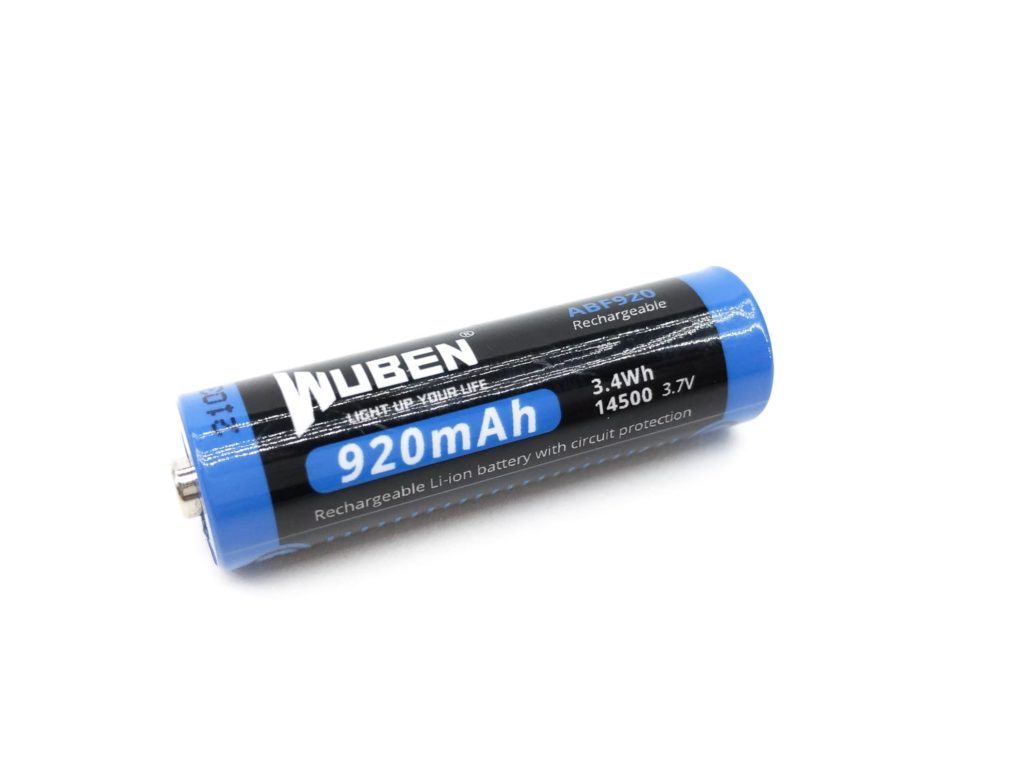
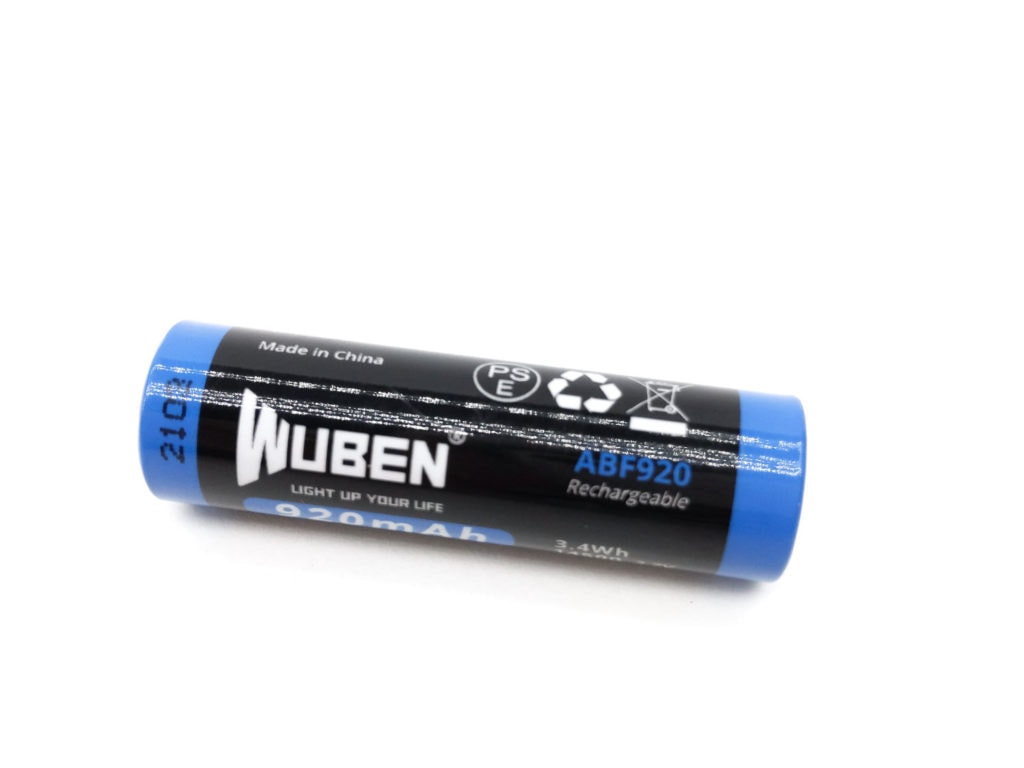
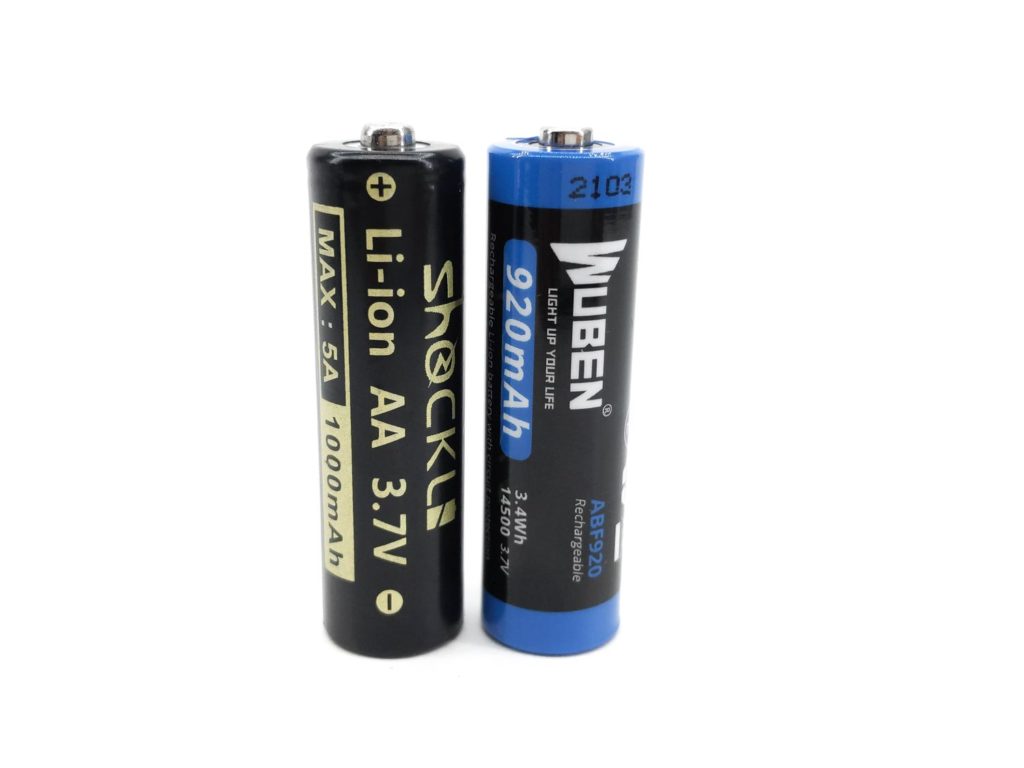
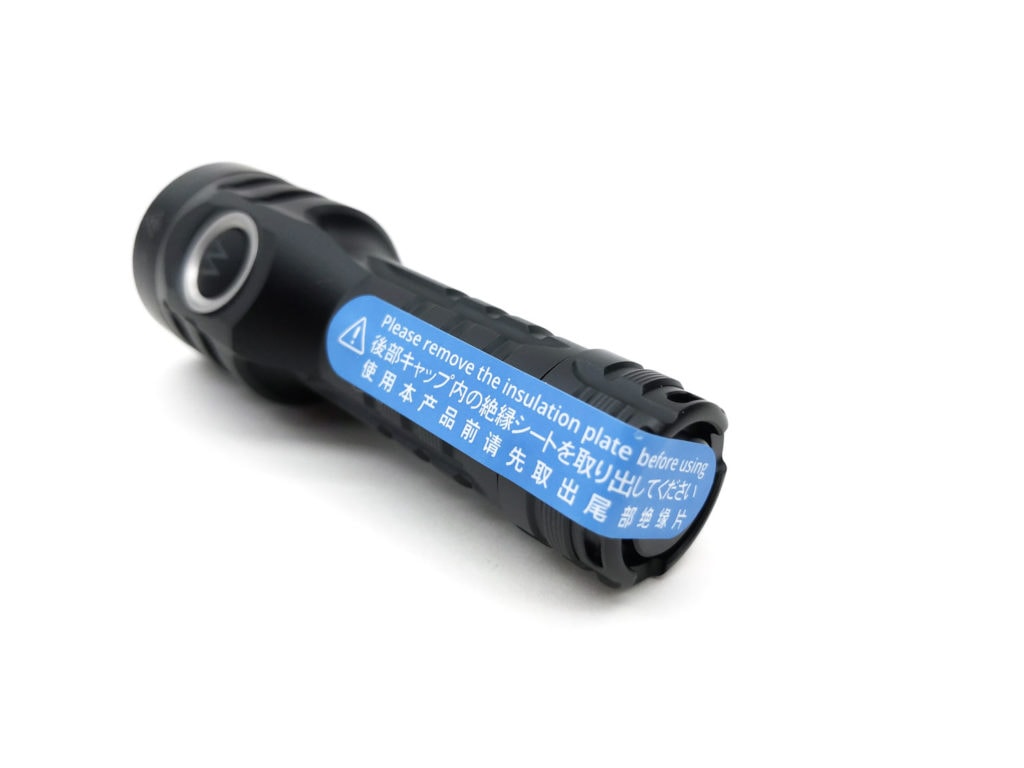
Performance
For current measurements, an ANENG AN8008 multimeter and UNI-T UT210E clamp meter were used. Lux was measured by a UNI-T UT383 BT at 10 meters. Lumens were measured in a homemade lumen tube using a TSL2591 sensor, calibrated with a Maukka calibration light. Testing was performed with (1) the included Wuben lithium-ion battery, (2) a genuine Eneloop Pro AA (2450 mAh), and an AC Delco Alkaline AA.
Parasitic drain:
- NiMH, breathing indicator off: 299 uA
- NiMH, breathing indicator on: ~2.1 mA
- Lithium, breathing indicator off: 116 uA
- Lithium, breathing indicator on: 0.7 mA
Runtime graph
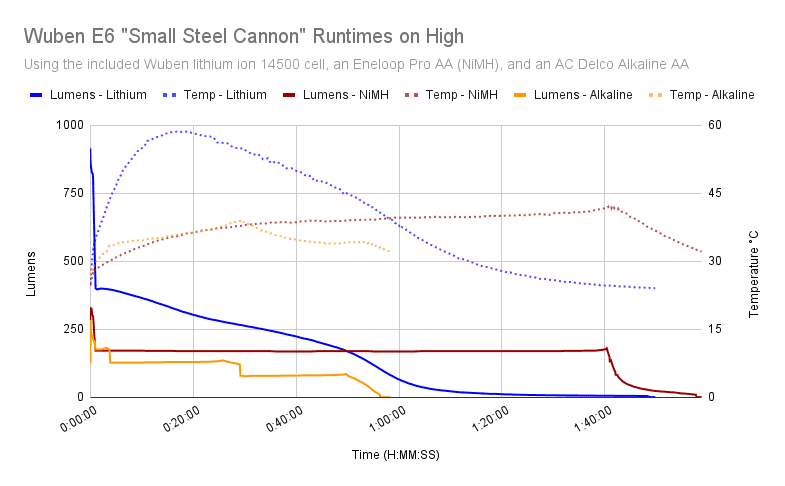
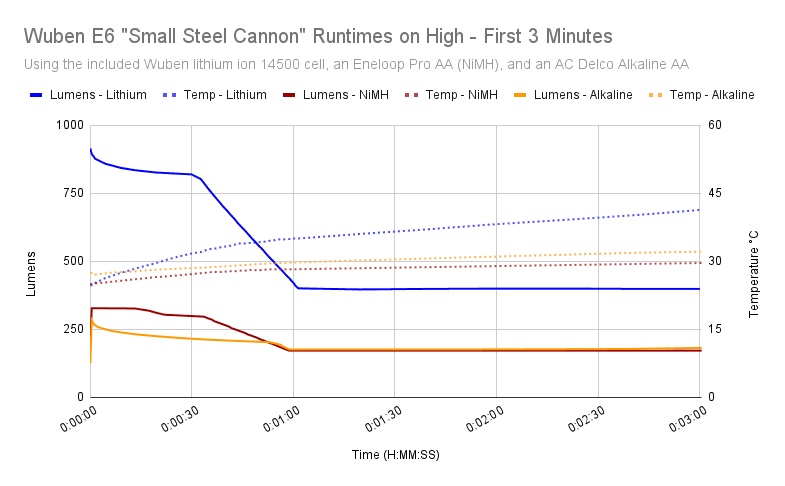
The High test using a lithium-ion battery started out at 915 lumens and slowly dropped over the first 30 seconds as the battery voltage sagged. At 30 seconds it was 819 lumens, then the timed ramp-down kicked in and quickly dropped to 400 lumens over the next 30 seconds. The output slowly declined as the battery voltage weaned. Runtime to 10% output was 58 minutes. The light shut off at1 hour 49 minutes. The maximum temperature was 59°C.
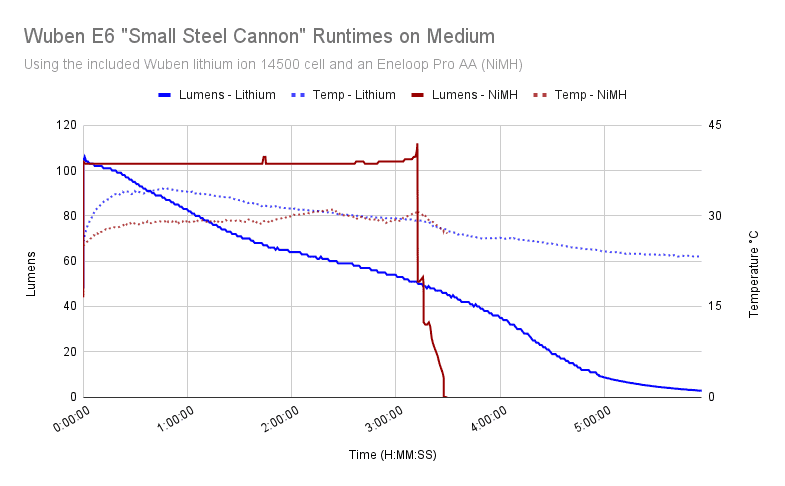
The Medium test on lithium started out at 104 lumens and was still there at the 30 second mark. Medium does not have a ramp-down, rather the output slowly decreased throughout the run. The runtime to 10% was 4 hours 56 minutes. Maximum temperature of 34°C.
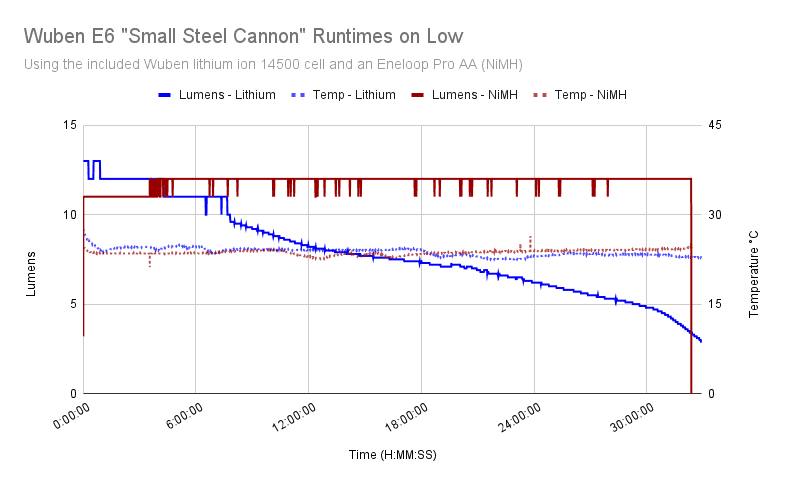
The Low test on lithium started out at 13 lumens and was still there at the 30 second mark. Like High and Medium, the output slowly decreased throughout the run. The runtime to 10% was beyond 34 hours (my logging terminated prematurely) where the output was still at 3 lumens.
The High test using NiMH understandably has a lower output than with lithium-ion. It started at 327 lumens and was at 303 at the 30 second mark. Like with the High mode with lithium ion, there was also a timed ramp-down at 30 seconds, output decreased to 171 lumens and held flat. The runtime to 10% was 1 hour 47 minutes. The light shut off at 1 hour 57 minutes. Maximum temperature was 42°C.
The Medium test using NiMH started out at 103 lumens and held that steady for just over 3 hours. Runtime to 10% was 3 hours 27 minutes, and the light shut off seconds later.
The Low test using NiMH started out at 11 lumens and held that steady for 32 hours and 22 minutes.
I also ran a test using an AC Delco alkaline AA battery. The test started out at 284 lumens and had dropped to 217 lumens by 30 seconds. By 4 minutes, the output dropped to 127 lumens. It dropped again at 30 minutes down to 77 lumens. Runtime to 10% was only 55 minutes. The light shut off a minute later. As can be seen by the output graph, alkaline batteries just aren’t made to handle this high of an amp draw. They struggle to provide that much current and their capacity drops drastically.
Lumen measurements (for each mode)
| Mode | Amps | Specs | 10min | 30 sec | start |
| Low, NiMH | 66 mA | 10 | 11 lm | 11 lm | 11 lm |
| Low, Lithium | 48 mA | 10 | 13 lm | 13 lm | 13 lm |
| Med, NiMH | 0.8 A | 100 | 103 lm | 103 lm | 104 lm |
| Med, Lithium | 330 mA | 100 | 102 lm | 104 lm | 104 lm |
| High, Alkaline | — | — | 127 lm | 217 lm | 284 lm |
| High, NiMH | 3.3 A | 350 > 170 | 171 lm | 303 lm | 327 lm |
| High, Lithium | 3.1 A | 900 “max” | 368 lm | 819 lm | 915 lm |
Throw numbers:
- Spec: 42,000 cd / 410 meters (using lithium ion)
- Measured, lithium ion @ 0 seconds: 51,800 cd / 455 meters / 498 yards
- Measured, lithium ion @ 30 seconds: 45,200 cd / 425 meters / 465 yards
- Measured, NiMH @ 0 seconds: 18,800 cd / 274 meters / 300 yards
- Measured, NiMH @ 30 seconds: 17,300 cd / 263 meters / 288 yards
Beamshots
- Beam shots of the building are taken at 15 m (16 yd) using a Pixel 3 set to ISO 200 with 1/10 second exposure time
- Beam shots of the playset are taken at 30 m (33 yd) using a Pixel 3 set to ISO 200 with 1/2 second exposure time. The trees in the background are around 65 m away.
- Wuben E6
- Astrolux EC01
- Xtar B20
- Nitecore P20i UV
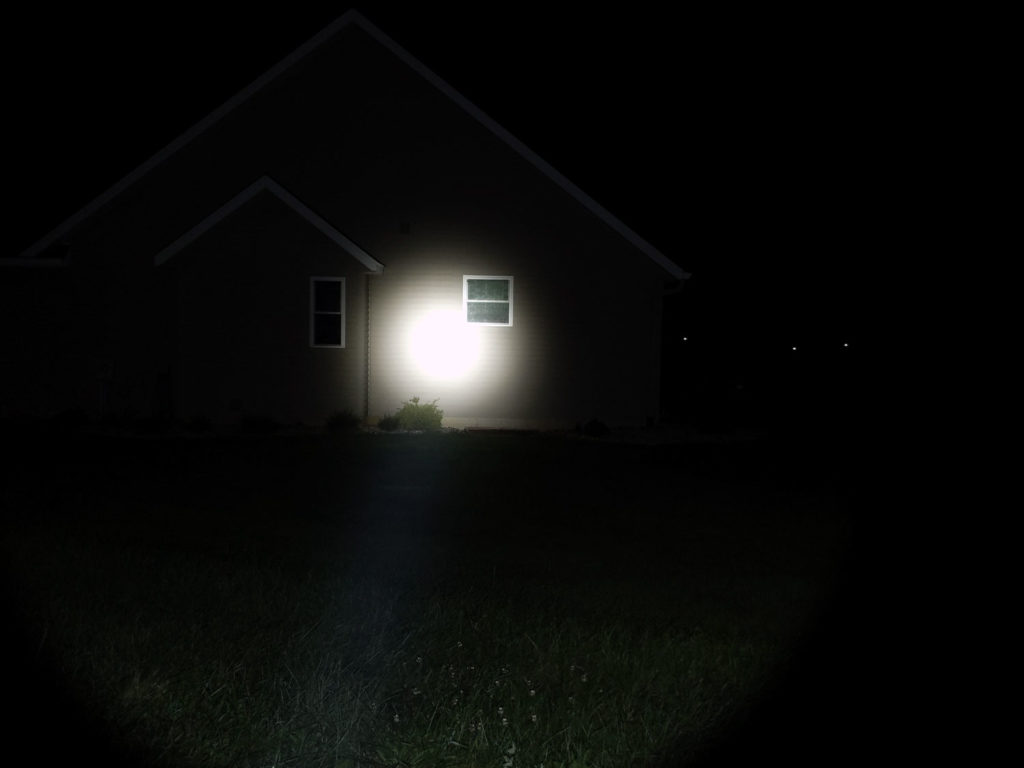
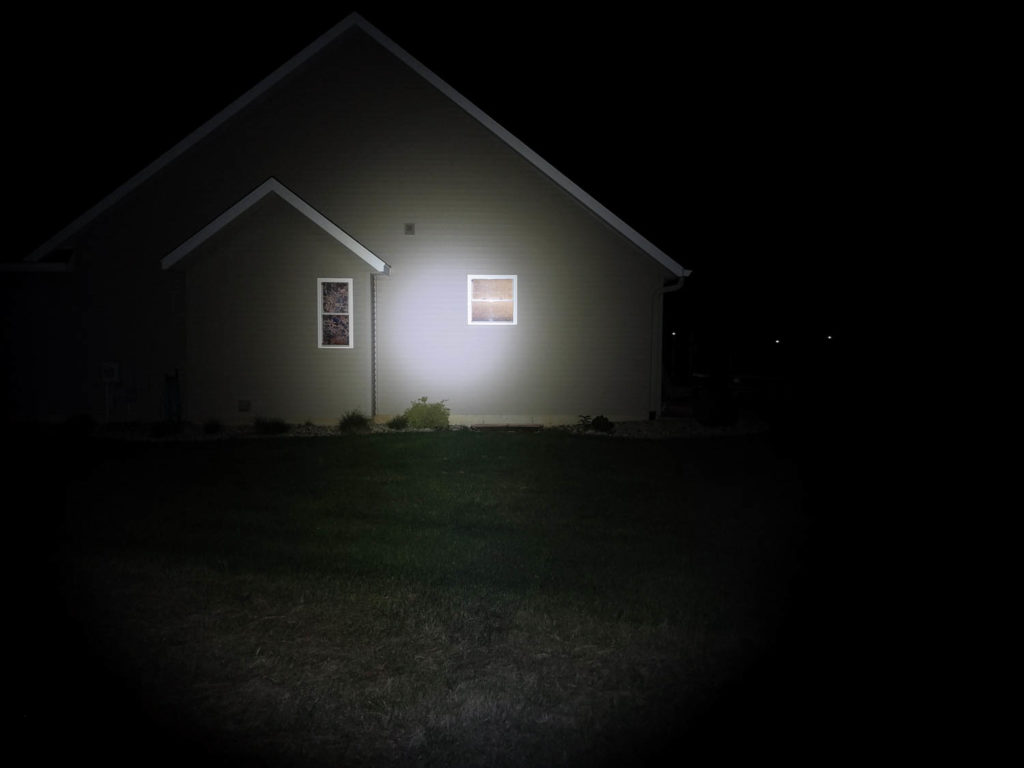

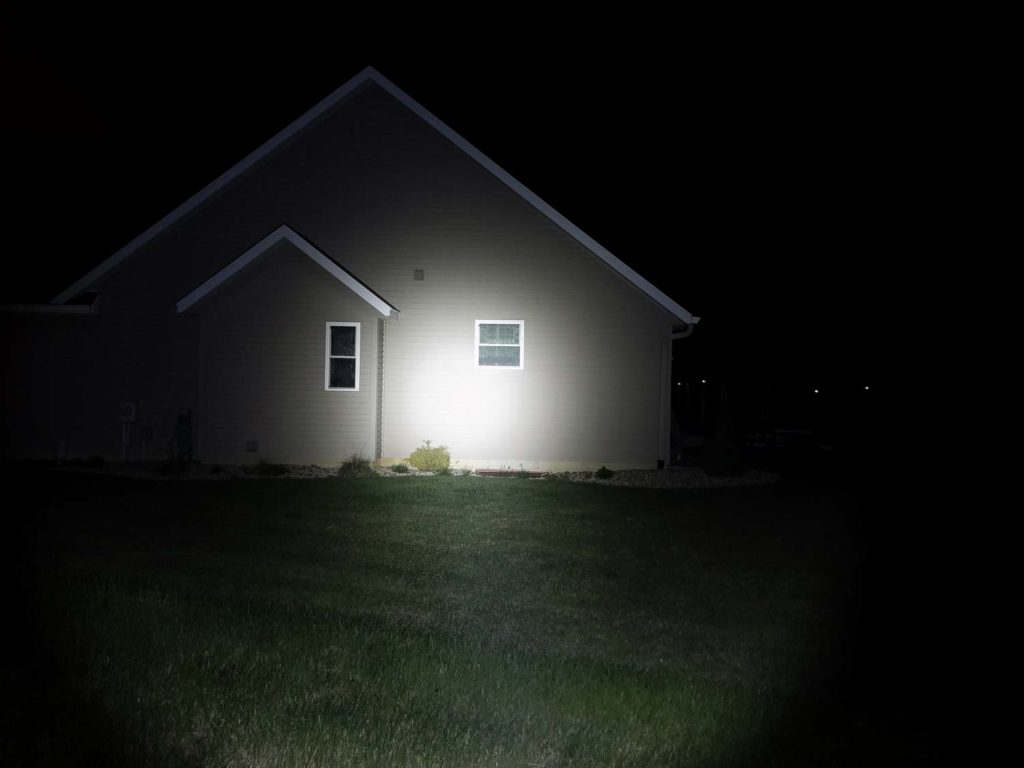
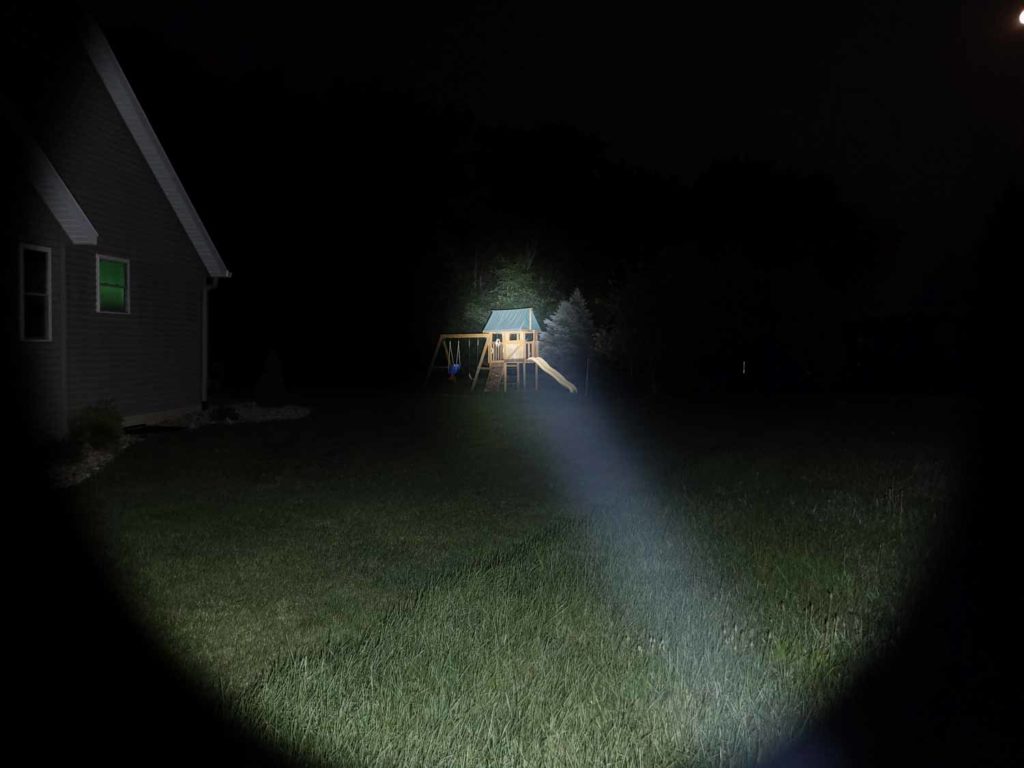
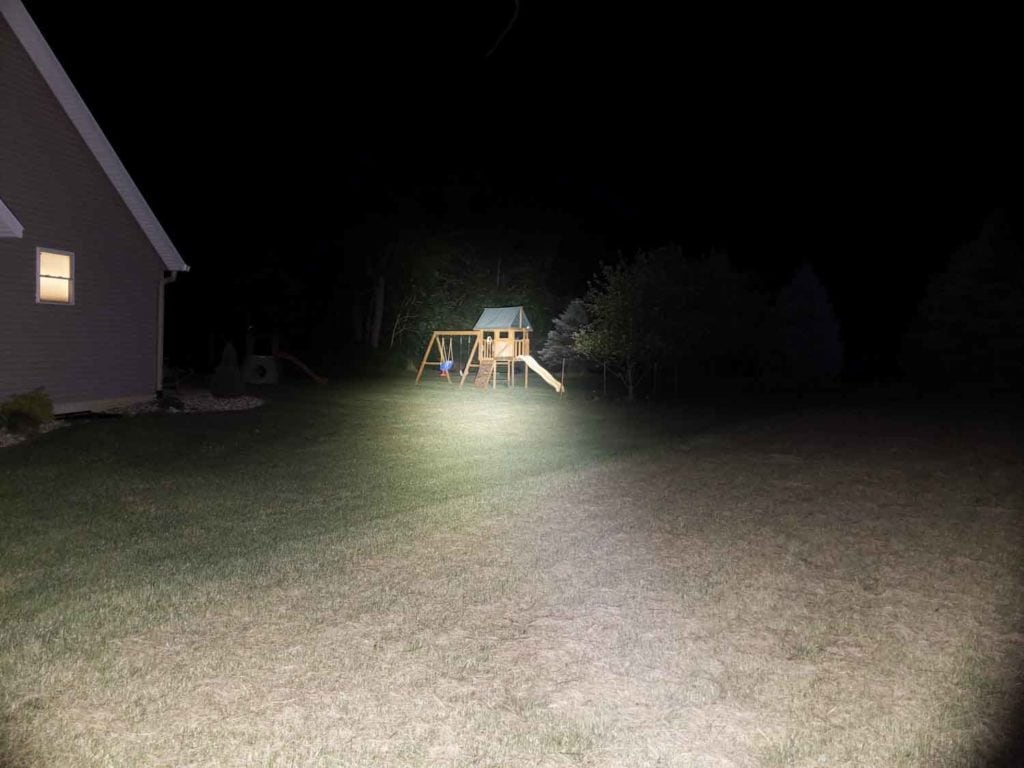
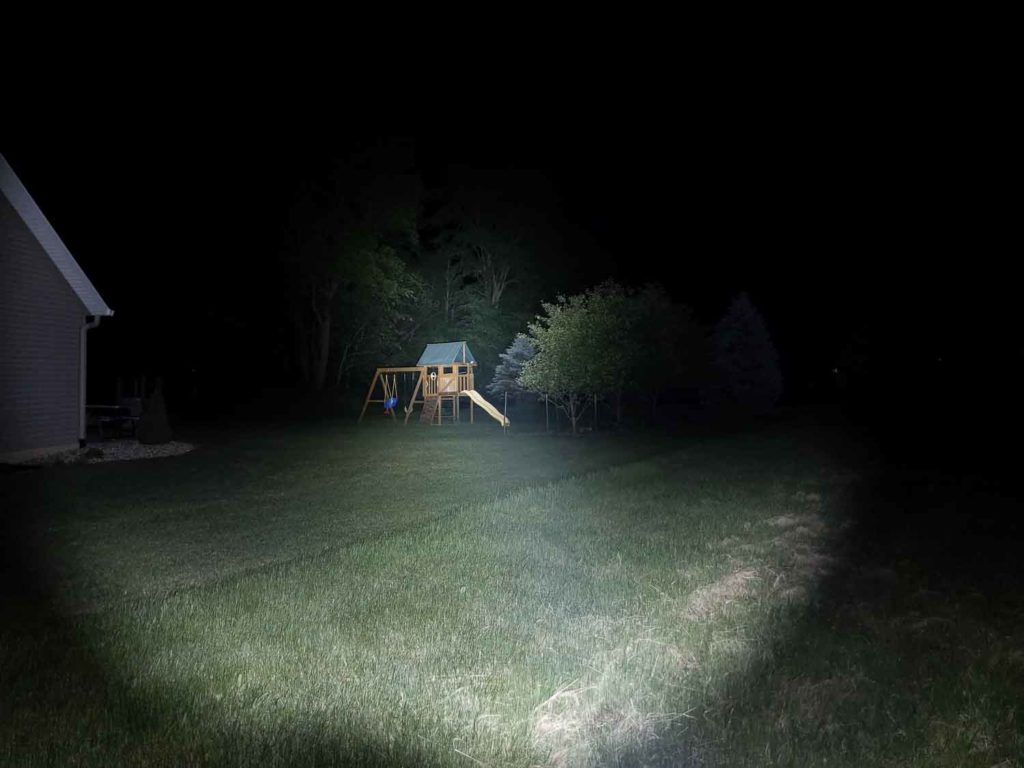
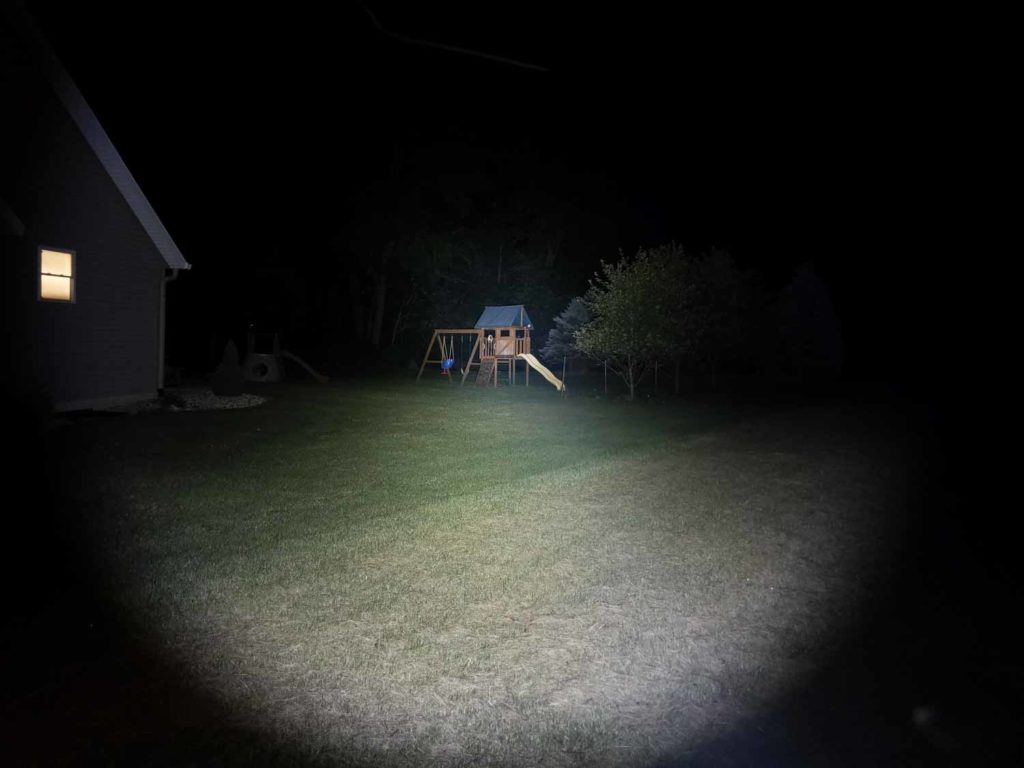
Disclaimer: I bought this flashlight with my own money. Nobody paid me to review this flashlight, nor have I been holding back on problems or defects.
Final Verdict
Pros
- Well built
- Very throwy
- Easy UI
- Compact
Cons
- No UI shortcuts
Explanation on star ratings:
1: Avoid: my phone flashlight would be a better choice – 2: Poor: significant defect or issues, much better options available at the same price – 3: Average: some defects or issues – 4: Good: recommended (minor issues) – 5: Great: highly recommended

5 stars: ★★★★★
I came into this review expecting great things and Wuben delivered! The Wuben E6 “Small Steel Cannon” feels like it’s built like, well, a cannon. The appearance is very rugged. The output / performance is great, and thanks to the OSRAM KW CSLPM1.TG LED, this cannon throws better than any AA/14500 light that I’ve ever experienced. It even performs extremely well on a single NiMH. Sure, I would have liked to have seen some UI shortcuts (to Low and High), but it is a very easy-to-use UI that takes no time to pick up on. This light is very easy to recommend if you’re looking for a compact thrower. I have a feeling like it’s going to quickly become a favorite of mine.
Buy Wuben E6 at a discount
If you buy directly from Wuben, make sure you use our exclusive discount code. Add coupon code 1Lumen20 at checkout to get 20% off.
1lumen selects and reviews products personally. We may earn affiliate commissions through our links, which help support our testing.